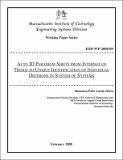| dc.contributor.author | Datta, Shoumen | |
| dc.date.accessioned | 2008-07-31T10:51:53Z | |
| dc.date.available | 2008-07-31T10:51:53Z | |
| dc.date.issued | 2008-07-31T10:51:53Z | |
| dc.identifier.uri | http://hdl.handle.net/1721.1/41900 | |
| dc.description | Auto id and concomitant location of object are important data elements whose value is growing exponentially in business supply chains. It is even more critical for security of global trade, for example, in multi-national logistics operations such as goods transport between Asia and Europe on the Trans-Siberian Railroad. In such systems, fixed frequency RFID tools may be a hindrance to operations and are liable to create gaps in (data) transparency due to lack of systems interoperability. This article highlights select technologies that may reduce frequency heterogeneity for some applications. | en |
| dc.description.abstract | Return on investment (ROI) from radio frequency (RF) based tools of identification may increase with the diffusion of frequency agnostic modes of radio frequency identification (RFID), such as, ultrawideband (UWB). Similarly, fixed frequency readers may be replaced with interrogators that can operate in any frequency, such as software defined radio (SDR). Identification of objects provides data that may not be useful unless the process of data acquisition is further linked to systems where the data can be analysed and useful information extracted. This evolution remains incomplete because data about objects is only a small segment of necessary information. Global businesses and systems, such as healthcare, demand much more than object data. Often processes and plans as well as prior decisions are taken into account when deciding on a future course of action or the next step. Current practice of auto id, although useful, remains only a small part of what is necessary for identification of information in complex system of systems. Identification, therefore, must encompass systems interoperability as well as the ability to enumerate both tangible and intangible elements that contribute to decisions. The unique “address” must be preserved during information exchange and decision support between systems to ensure interoperability. | en |
| dc.description.sponsorship | MIT Forum for Supply Chain Innovation
http://supplychain.mit.edu/shoumen | en |
| dc.language.iso | en | en |
| dc.subject | Auto ID, RFID, EPC, IPv6, Information Age, Sensors, UWB, SDR, Decision Systems, Interoperability, Systems Age | en |
| dc.title | Auto ID Paradigm Shifts from Internet of Things to Unique Identification of Decisions in System of Systems | en |
| dc.type | Working Paper | en |
